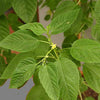Corchorus Capsularis 20/100 Seeds, White Jute Herb, Annual Perennial Plants, Garden Burlap
The Plant Attraction
$2.99
Corchorus Capsularis
Also known as: White Jute
This species provides the greatest part of the jute commerce (burlap, cordage, gunny), with its strong and coarse fiber, about ten times more abundant than Corchorus olitorius, another source of jute. This species is considered to be of the finer quality. Jute yarn has replaced flax and hemp in sackcloth. Sacking is the bulk of manufactured jute products. The yarn is also used in weaving curtains, chair coverings, carpets, and rugs. It is blended with other fibers in making toys, decorative wall hangings, lamp shades and shoes. Also used for rigid packaging, reinforcing plastic, and replacing wood in pulp and paper making. Finely carded and highly absorptive this fiber is used as basis for antiseptic surgical dressings.
It is a annual/perennial growing to 3.5 m (11-12 feet) at a fast rate. It is hardy to 30° to 40°F (-1° to +4.5°C). Makes a nice potted plant-grows about 2' tall and bears yellow flowers if not clipped for food use.
It is in flower in August, and the seeds ripen in October. The flowers are hermaphrodite (having both male and female organs) and are pollinated by Insects.
This plant is high in protein, rich in beta carotene, iron, calcium, and vitamin C. It's eaten as a vegetable in North Africa, the middle and near east, Bangladesh, and South East Asia. It makes an excellent spinach substitute, raw or cooked. The dried leaves can be used as a thickener in soups. The seeds are used as a flavoring, and a herbal tea is made from the dried leaves.
Choose from packs of 20 or 100 seeds!
Also known as: White Jute
This species provides the greatest part of the jute commerce (burlap, cordage, gunny), with its strong and coarse fiber, about ten times more abundant than Corchorus olitorius, another source of jute. This species is considered to be of the finer quality. Jute yarn has replaced flax and hemp in sackcloth. Sacking is the bulk of manufactured jute products. The yarn is also used in weaving curtains, chair coverings, carpets, and rugs. It is blended with other fibers in making toys, decorative wall hangings, lamp shades and shoes. Also used for rigid packaging, reinforcing plastic, and replacing wood in pulp and paper making. Finely carded and highly absorptive this fiber is used as basis for antiseptic surgical dressings.
It is a annual/perennial growing to 3.5 m (11-12 feet) at a fast rate. It is hardy to 30° to 40°F (-1° to +4.5°C). Makes a nice potted plant-grows about 2' tall and bears yellow flowers if not clipped for food use.
It is in flower in August, and the seeds ripen in October. The flowers are hermaphrodite (having both male and female organs) and are pollinated by Insects.
This plant is high in protein, rich in beta carotene, iron, calcium, and vitamin C. It's eaten as a vegetable in North Africa, the middle and near east, Bangladesh, and South East Asia. It makes an excellent spinach substitute, raw or cooked. The dried leaves can be used as a thickener in soups. The seeds are used as a flavoring, and a herbal tea is made from the dried leaves.
Choose from packs of 20 or 100 seeds!

























